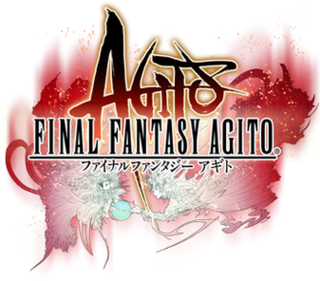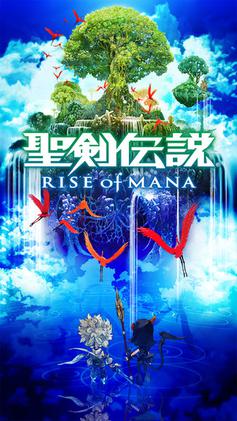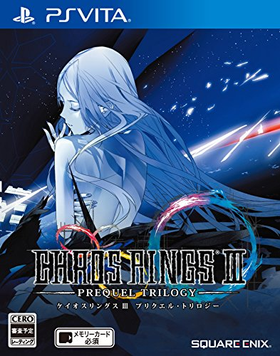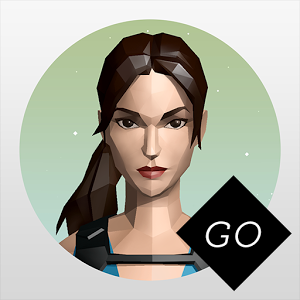
The Mana series, known in Japan as Seiken Densetsu, is a high fantasy action role-playing game series created by Koichi Ishii, with development formerly from Square, and is currently owned by Square Enix. The series began in 1991 as Final Fantasy Adventure, a Game Boy handheld side story to Square's flagship franchise Final Fantasy. The Final Fantasy elements were subsequently dropped starting with the second installment, Secret of Mana, in order to become its own series. It has grown to include games of various genres within the fictional world of Mana, with recurring stories involving a world tree, its associated holy sword, and the fight against forces that would steal their power. Several character designs, creatures, and musical themes reappear frequently.
Hitman is a stealth game franchise created by Danish developer IO Interactive. The player controls the contract killer Agent 47, who travels the world to assassinate various targets who are assigned to him.

Romancing SaGa 2 is a 1993 role-playing video game developed and published by Square for the Super Famicom. It is the fifth entry in the SaGa series. It received an expanded port for Japanese mobile devices from Square Enix in 2011. This version was remastered by ArtePiazza and released worldwide between 2016 and 2017 by Square Enix for Android, iOS, PlayStation Vita, Nintendo Switch, PlayStation 4, Windows and Xbox One.

Crystal Defenders is a set of two tower defense video games developed and published by Square Enix. The games use the setting of Ivalice and design elements from Final Fantasy Tactics A2: Grimoire of the Rift, forming part of the wider Final Fantasy franchise. The games feature a selection of characters sporting Final Fantasy-based character classes, and play out tower defense scenarios against recurring series of monsters. The first game in the series is Crystal Guardians, which was released in three parts for Japanese mobile phones in 2008. It was adapted for iOS later that year as Square Enix's first game for the platform, and renamed Crystal Defenders. Under that name, the game was also released between 2009 and 2011 for Android, Xbox Live Arcade, WiiWare, and PlayStation 3 and PlayStation Portable via the PlayStation Store. It was re-released with graphical improvements for iOS as Crystal Defenders Plus in 2013. A sequel, Crystal Defenders: Vanguard Storm, was released for iOS in 2009.

Chaos Rings is a role-playing video game developed by Media.Vision and published by Square Enix. It was released worldwide in 2010 as an exclusive title for iOS, but it was later ported to the Android, Windows Phone 7, and PlayStation Vita. Effective May 31, 2016, Square Enix ended distribution of this title, and it is no longer available for download or purchase. Produced by Takehiro Ando, characters were designed by Yusuke Naora, the art director of Final Fantasy VII, VIII, and X among other successful titles.

Chaos Rings II was a role-playing video game developed by Media.Vision and published by Square Enix. The game released on 14 March 2012, one day ahead of schedule. Effective May 31, 2016, Square Enix ended distribution of this game, and it is no longer available for download except on the Amazon App Store. It is the sequel to Chaos Rings, and the third game in the Chaos Rings series that consists of the prequel Chaos Rings Omega and the original game. A teaser trailer for the game has been released by Square Enix. Like the previous games in the series, the game features voice acting. The game was taken down from app stores on May 31, 2016.

Chaos Rings Omega is a role-playing video game for iOS, Android, and PlayStation Vita developed by Media.Vision and published by Square Enix. Chaos Rings Ω was available on the App Store on May 19, 2011. Effective May 31, 2016, Square Enix ended distribution of this title on the AppStore and Google Play, where it is no longer available for download now except for on Amazon App Store. It is the prequel to Chaos Rings.

Final Fantasy Agito was a role-playing video game developed and published by Square Enix for mobile devices. The game's story was set in the universe of Final Fantasy Type-0, and was an entry in the Fabula Nova Crystallis subseries. A downloadable episodic game similar to Final Fantasy Dimensions, it featured a turn-based combat system encouraging both single-player exploration and multiplayer combat. There was a day-night cycle tied to the real-world time of day, and it featured a social element whereby talking with and befriending certain characters advanced the player's ranking in the game.

Rise of Mana is a Japanese action role-playing video game developed by Goshow for iOS, Android and PlayStation Vita. It was published by series creator Square Enix in 2014 for mobile devices and 2015 for the Vita. It is the eleventh game in the Mana series, featuring a new narrative unconnected to other games in the series. The gameplay uses a similar action-based battle system to earlier Mana titles while using a free-to-play model in common with mobile titles. The story focuses on two characters, an angel and a demon, who are cast down to the mortal world in the midst of a battle and are forced to share a body in order to survive.

Chaos Rings III is a 2014 Japanese role-playing video game developed by Media.Vision and published by Square Enix. It is the fourth game in the Chaos Rings series, after Chaos Rings, Chaos Rings Omega, and Chaos Rings II. Like its predecessors, it was released on iOS, and Android devices, but also the first to be released for the PlayStation Vita platform. The PS Vita release, titled Chaos Rings III: Prequel Trilogy contains all four titles in the Chaos Rings series.

Hitman Go is a turn-based puzzle video game developed by Square Enix Montréal and published by Square Enix's European subsidiary. Announced in February 2014, the game was released for iOS in April 2014 and for Android in June 2014. Windows and Windows Phone versions were released the following year in April 2015. In February 2016, a "Definitive Edition" version was released on PlayStation 4, PlayStation Vita, and on Linux and Windows via Steam. It is the first game developed by Square Enix Montréal, a studio founded in 2011. Development entered full production in 2013 and was completed by eleven people using the Unity game engine.

Mobius Final Fantasy was an episodic role-playing video game developed and published by Square Enix for iOS, Android, and Microsoft Windows. It was released in Japan in June 2015, and internationally in August 2016. The players could control Warrior of Light (Wol), a man who wakes with amnesia in the world of Palamecia, and must help conquer the dark forces attacking its people. The game featured gameplay elements from previous Final Fantasy titles, including leveling, exploration via standard navigation and fast-travel systems, and turn-based combat tied to a job system. Common themes were also drawn from the original Final Fantasy title, such as "warriors of light" and their fight against chaos and darkness.

Dragon Quest Heroes: The World Tree's Woe and the Blight Below is a hack and slash game developed by Omega Force and published by Square Enix. It was released for PlayStation 3 and PlayStation 4 in Japan in February 2015, and in North America, Australia and Europe only for PlayStation 4 in October 2015. It was later released for Microsoft Windows in December 2015. The game received generally positive reviews, with a sequel Dragon Quest Heroes II being released in Japan during May 2016. Dragon Quest Heroes would later be released with the sequel in a compilation for Nintendo Switch in Japan.

Lara Croft Go is a turn-based puzzle video game in the Tomb Raider series. The player moves Lara Croft as a puzzle piece through a board game while avoiding obstacles and manipulating the environment. The developers distilled major series motifs, such as boulder-chases and reaction-based gameplay, to suit Lara Croft Go's time-independent gameplay. Square Enix Montréal developed the game as a spiritual successor to its 2014 Hitman Go, based on another Square Enix Europe franchise. It was released in August 2015 for Android, iOS, Windows, and Windows Phone devices. Versions for PlayStation 4, PlayStation Vita and Steam were released in December 2016.

Hitman: Sniper is a 2015 mobile shooting gallery video game in the Hitman series by Square Enix Montréal. As the series' mainstay protagonist Agent 47, the player looks through a first-person sniper scope vision on their touchscreen device to assassinate several powerful figures who have assembled at a lakeside compound without alerting their associates. The player uses the environment to find creative ways to kill these targets, sometimes prompted by secondary objectives. Through mission progression, the player unlocks more powerful weapons and new weapon abilities.

Adventures of Mana is an action role-playing video game developed by MCF and Square Enix, and published by Square Enix. It is a 3D remake of the 1991 Game Boy game Final Fantasy Adventure, the first game in the Mana series. It was released worldwide for Android and iOS on February 4, 2016; a PlayStation Vita version was also released on the same date in Japan, and in June 2016 in North America, South America and Europe. In addition to these releases, Square Enix has said that they are considering developing versions for PlayStation 4 and personal computers.
Final Fantasy Crystal Chronicles is a series of video games within the Final Fantasy franchise developed by Square Enix. Beginning in 2003 with the game for the GameCube, the series has predominantly been released on Nintendo gaming hardware and covers multiple genres, including action role-playing. The Crystal Chronicles series takes place in an unnamed world inhabited by four tribes. Recurring themes include creating objects from memory and the importance of family. The gameplay, which has always been aimed at as wide an audience as possible within a genre, generally involves either multiple players or a large group working together.















